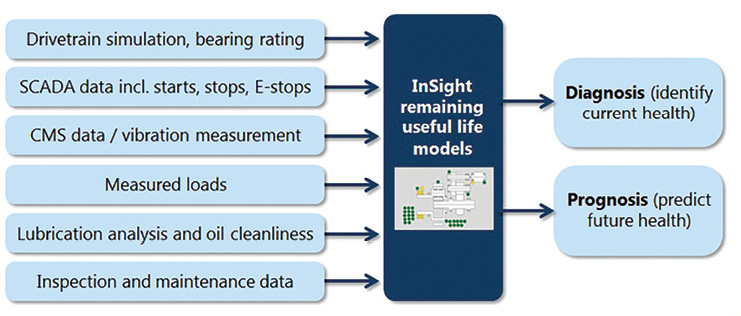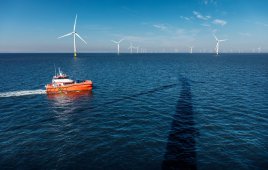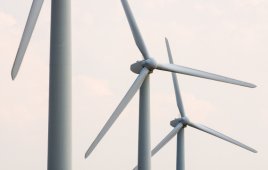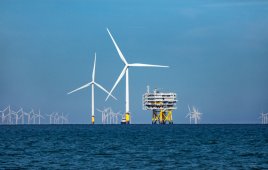Matthew Whittle / Product Manager /Romax / www.romaxtech.com
Operations and maintenance (O&M) of wind turbines is estimated at 21 to 24% of the total cost of energy from wind. As turbines are built larger, the capital-expenditure component of the cost of energy from wind drops, but there is still room to reduce the cost of O&M.
Too often maintenance is carried out reactively: the asset fails and it is repaired. This is a good approach when the asset is inexpensive, easy to source, and when the inevitable downtime does not have major cost, or health and safety implications. But operators too often take a reactive approach to major wind-turbine components such as main bearings or gearboxes failures. This results in expensive crane mobilisations at short notice and lost production while the turbine is unavailable. Failures during the high-wind season can be costly.

The plot indicates a main bearing health as its turbine ages. Vibration signals began increasing mid- October and reached a repair point after the following August.
An alternative is to carry out preventative maintenance, periodic replacement whether the component seems failing or not. This approach is useful for expensive mission critical components, particularly where the component condition is difficult to monitor.
A third approach is predictive condition-based maintenance. This is suitable for components when its condition can be monitored and a failing component can be detected sufficiently far in advance of a date of failure. To be useful, how far in advance must this warning be received? That depends on many factors, but the period must be sufficient to allow at least some of the following benefits:
- Prevent secondary damage to other components
- Secure necessary resources in advance at reduced cost
- Carry out multiple maintenance activities at once, thereby reducing the cost such as replace multiple main bearings and gearboxes with one crane mobilisation.
- Minimize downtime, thereby increasing production
- Schedule downtime at a low impact time, such as during the low-wind season
- Use cost effective life extension methods to mitigate damage
 Predictive condition-based maintenance can be online or offline. Many recent wind turbines come with factory-fitted vibration based condition monitoring system (CMS) for online monitoring. Or, one can be retrofitted. Effective offline techniques include lubrication analysis and vibration sweeps using portable vibration hardware.
Predictive condition-based maintenance can be online or offline. Many recent wind turbines come with factory-fitted vibration based condition monitoring system (CMS) for online monitoring. Or, one can be retrofitted. Effective offline techniques include lubrication analysis and vibration sweeps using portable vibration hardware.
For example, to provide decision makers with a clear picture of the health of their fleet, Romax’s InSight Fleet Monitor, web-based Software as a Service uses data from existing CMS and SCADA systems together, with lubrication analyses and operations-and-maintenance records. InSight Fleet Monitor has a range of detection and prediction methods to enable condition-based maintenance of wind turbines. The following case study is a typical example of a main bearing fault detection carried out using the company’s CBM.
Case study: Main bearing fault
An upward trend from a fleet monitor health index from October 2013 indicated a main bearing fault. The illustration Fleet Monitor main bearing health plots the trend. The trend continued upwards and in August 2014 the bearing was inspected and the damage confirmed (spalling and rollover marks). While the main bearing replacement was scheduled, the turbine continued running but with close monitoring. By detecting this fault 12 months before repair was required it is possible to minimize downtime and schedule multiple main bearing change-outs together. Power production was increased and crane mobilisation costs were reduced.
Condition monitoring of wind-turbine drivetrains has proven to be effective, but it must be part of an integrated predictive maintenance strategy to yield significant financial rewards. Merely identifying that a component is damaged does not increase the profitability of a turbine or farm. It is necessary to act on the information to optimise the O&M activity. Condition monitoring centers must not be isolated from site managers and asset-management teams. Integrated condition monitoring tools, such as Romax’s InSight Fleet Monitor, help condition monitoring technicians diagnose turbine faults early and efficiently. In addition, they aid collaboration with other key departments. Designed with global access and collaboration in mind, Fleet Monitor lets site managers, asset management teams, and condition-monitoring centers communicate and collaborate more effectively.
But key questions remain for wind farm operators:
- How does management weigh the trade-offs inherent in decisions regarding component life extension?
- How can a team optimize the timing of component replacements?
- How can an owner budget O&M expenditures over the next three years?
Remaining useful life models
While vibration based condition monitoring detects developing faults, it cannot give an indication of the remaining useful life of a component which has not yet started to fail. This creates a challenge for operators wishing to implement a condition-based maintenance strategy, namely one posed by the question: How can a company budget O&M expenditures over the next 3+ years?
Each bearing and gear in the drivetrain of a wind turbine has a design life. This life is consumed as the turbine operates, but one hour at rated power does not consume damage at the same rate as one hour at 50% rated power. Also the turbine undergoes transient loading, during gusts, or when the turbine starts and stops, for example. All of these events consume a portion of the design life of each component. The remaining useful life model calculates how much component life is used by the different operational regimes and events, and deducts this from the design life.
The approach is to use all available historical data from the CMS (when installed), SCADA, lubrication analysis, inspection and maintenance records, combined with measured loads and then calibrate the remaining useful life models for each bearing and gear in the turbine. This hybrid approach, using computer models and empirical data, has been developed based on extensive domain experience. Failures in turbines are complicated and unexpected things can happen. For instance:
- Bolts back out
- Rollers wear on the end face generating damaging debris
- Oil degrades
- Bearings are ground with incorrect micro-geometry
- Gears have inclusion related early failures
- Bearings spin in their journals
- Damage starts due to poor assembly
This practical knowledge has been combined with sophisticated computer models to create an effective remaining useful life tool, which has been subject to validation campaigns with major operators over many years.
Case study: Remaining useful life models
The plots in Remaining useful life illustrate a study in which the high speed, upwind bearing in a gearbox rapidly accumulated damage during its first year of operation. The gearbox was replaced due to serial defects. The same bearing in the replacement gearbox accumulated damage rapidly and after two years was replaced up tower. Unfortunately the new bearing consumed life even more quickly due to poor oil cleanliness. Debris introduced during the up-tower repair was a key factor in the reduced life.
Remaining useful life models are powerful because they allow taking early action to mitigate damage. Running different what-if scenarios shows the impact on the remaining useful life of different approaches, and weighing cost versus benefits. Also, the advanced warning gained from predictive models, make possible more accurate O&M budgeting.
What we have learned
The powerful tool of condition monitoring allows detecting faults before they progress to failure. After detecting a fault, wind farm operators must make important decisions. These decisions will affect whether or not the value of the condition monitoring is realised, and tools are required to assist decision makers. Two different approaches to prognosis have been discussed. The first approach is a method for estimated time to repair once a failure has begun. The second approach use models which estimate damage accumulation to give a longer term forecast which can be used for budgetary planning. The cost of wind energy must be reduced. To achieve that cost reduction, predictive condition-based maintenance will play an increasingly important role. 
Filed Under: Featured, O&M




